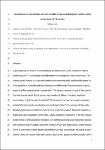Optimisation of classification methods to differentiate morphologically-similar pollen grains from FT-IR spectra
| dc.contributor.author | Scoble, L | |
| dc.contributor.author | Ussher, S | |
| dc.contributor.author | Fitzsimons, M | |
| dc.contributor.author | Ansell, L | |
| dc.contributor.author | Craven, M | |
| dc.contributor.author | Fyfe, R | |
| dc.date.accessioned | 2023-12-18T15:30:57Z | |
| dc.date.available | 2023-12-18T15:30:57Z | |
| dc.date.issued | 2023-12-29 | |
| dc.identifier.issn | 1879-0615 | |
| dc.identifier.issn | 1879-0615 | |
| dc.identifier.other | 105041 | |
| dc.identifier.uri | https://pearl.plymouth.ac.uk/handle/10026.1/21812 | |
| dc.description.abstract |
A growing body of research is demonstrating the potential of Fourier-Transform Infrared spectroscopy (FT-IR) to identify and differentiate morphologically similar pollen taxa. The Poaceae (grass) family is a large and complex with morphologically similar pollen grains. It is not possible to use traditional light microscopy to differentiate Poaceae species, or genus, based on pollen morphological characteristics. This research presents a study of five species from the Poaceae family found across a wide variety of different moorland vegetation communities, to test the extent to which FT-IR microspectroscopy can be used to separate and identify these species and develop statistical approaches for the analyses of these data. Moorland grasses are of particular importance to assess conservation status and baselines in fragile and scarce vegetation communities, whose vegetation composition in the past remains cryptic owing to low taxonomic resolution. Non-differentiated and second derivative spectra were combined with Principal Component Analysis (PCA) and Hierarchical Cluster Analysis (HCA) to determine whether species had different chemical compositions and would cluster. Decision trees and random forest were used to classify each species and demonstrated 100% successful classification rate. This success demonstrates that using FT-IR microspectroscopy alongside spectral pre-processing and multivariate analysis can successfully identify and separate these moorland Poaceae species and has the clear potential to improve taxonomic resolution and classification of fossil pollen records. This will improve our understanding of how past land-use practice has shaped upland communities, provide more detailed ecologically-relevant palaeoecological information, and be utilised for the restoration and conservation of upland habitats. | |
| dc.format.extent | 105041-105041 | |
| dc.language | en | |
| dc.publisher | Elsevier | |
| dc.subject | Pollen | |
| dc.subject | Sporopollenin | |
| dc.subject | FT-IR | |
| dc.subject | Poaceae | |
| dc.subject | Random forest | |
| dc.title | Optimisation of classification methods to differentiate morphologically-similar pollen grains from FT-IR spectra | |
| dc.type | journal-article | |
| dc.type | Article | |
| plymouth.volume | 321 | |
| plymouth.publication-status | Published | |
| plymouth.journal | Review of Palaeobotany and Palynology | |
| dc.identifier.doi | 10.1016/j.revpalbo.2023.105041 | |
| plymouth.organisational-group | |Plymouth | |
| plymouth.organisational-group | |Plymouth|Research Groups | |
| plymouth.organisational-group | |Plymouth|Faculty of Science and Engineering | |
| plymouth.organisational-group | |Plymouth|Faculty of Science and Engineering|School of Geography, Earth and Environmental Sciences | |
| plymouth.organisational-group | |Plymouth|Faculty of Science and Engineering|School of Engineering, Computing and Mathematics | |
| plymouth.organisational-group | |Plymouth|Research Groups|Marine Institute | |
| plymouth.organisational-group | |Plymouth|REF 2021 Researchers by UoA | |
| plymouth.organisational-group | |Plymouth|Users by role | |
| plymouth.organisational-group | |Plymouth|Users by role|Academics | |
| plymouth.organisational-group | |Plymouth|REF 2021 Researchers by UoA|UoA10 Mathematical Sciences | |
| plymouth.organisational-group | |Plymouth|REF 2021 Researchers by UoA|UoA14 Geography and Environmental Studies | |
| plymouth.organisational-group | |Plymouth|Admin Group - REF | |
| plymouth.organisational-group | |Plymouth|Admin Group - REF|REF Admin Group - FoSE | |
| plymouth.organisational-group | |Plymouth|REF 2021 Researchers by UoA|ZZZ Extended UoA 10 - Mathematical Sciences | |
| plymouth.organisational-group | |Plymouth|REF 2028 Researchers by UoA | |
| plymouth.organisational-group | |Plymouth|REF 2028 Researchers by UoA|UoA10 Mathematical Sciences | |
| plymouth.organisational-group | |Plymouth|REF 2028 Researchers by UoA|UoA14 Geography and Environmental Studies | |
| dcterms.dateAccepted | 2023-12-17 | |
| dc.date.updated | 2023-12-18T15:30:51Z | |
| dc.rights.embargodate | 2024-1-3 | |
| dc.identifier.eissn | 1879-0615 | |
| rioxxterms.version | Accepted Manuscript | |
| rioxxterms.versionofrecord | 10.1016/j.revpalbo.2023.105041 |


